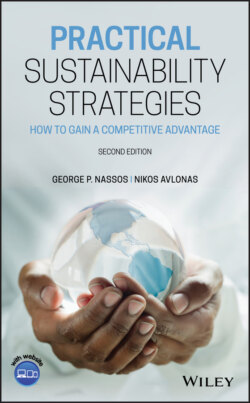Читать книгу Practical Sustainability Strategies - George P. Nassos - Страница 43
THE NATURAL STEP RECENT PROJECTS Interface—The First Company to Adopt the Natural Step
ОглавлениеInterface became the first US company to adopt TNS framework and methodologies [9]. Under the guidance of TNS and other sustainability visionaries, a new vision for Interface was later crafted—Mission Zero™; to eliminate any negative impact Interface has on the environment by 2020, showing it is possible to create a better world, and being restorative by the power of our influence.
Interface included aspects from TNS's Framework for Strategic Sustainable Development (FSSD) in the company's strategic planning process and all employees training. Gradually the FSSD became a vital and visible part in the company's operations and culture, and it was consistently positioned as providing the most rigorous definition of sustainability.
From 1996 to 2013, Interface reduced the manufacturing waste it sends to landfill by 84%. About 49% of all raw materials are now either recycled or bio-based, including 36% of yarn and 51% of carpet backing. Savings from avoided waste costs amounted to US$450 million. In terms of energy, total energy use at the global factories has been reduced by 39% per unit. Also, 36% of energy consumed globally is from 100% renewable sources (with seven out of nine facilities operating with 100% renewable energy), and actual greenhouse gas emissions have been reduced by 41%. Interface, Inc. today uses only 20% as much water to make products as they did in 1996. This is an impressive accomplishment, especially for a materials manufacturer, and shows the benefits of looking at a business through the lens of sustainability.
Twenty-two years ago, Interface Inc. started on a journey led by their founder, Ray Anderson. The company adopted a bold new vision—“To be the first company that, by its deeds, shows the entire industrial world what sustainability is in all its dimensions: people, process, product, place and profits—and in doing so—become restorative through the power of influence.” Reaching this vision meant that Interface would need to evolve into an entirely different kind of organization, but there was no blueprint for this kind of organization in business.
Interface started by asking how they could translate the operations of nature into a model for business. They relied heavily on TNS Framework to guide their thinking as they mapped out how to change their business. Interface ultimately developed the Seven Fronts of sustainability—seven key areas where Interface would focus to remake their company. Over the last 22 years, Interface has followed these Fronts and made progress reducing the impacts of the company and its reliance on natural resources. This has included a strong focus on the manufacturing operations where they traditionally used large amounts of raw materials, energy, and water.
As Interface approached the management of their manufacturing operations through a sustainability lens, they were able to identify numerous opportunities to not only conserve resources, but also cut costs.
Some savings have been the result of making fundamental shifts in how Interface manufactures its flooring products. For instance, engineers at Interface's Bentley Prince Street factory in California reconsidered the way they made carpet that resulted in a reduction of the water used to manufacture each unit by 47%. The company simply moved away from the chemical-intensive dye-injection and yarn dye methods for adding colors and patterns to their products. Dye-injection involved using a large machine, much like a big ink-jet printer, to apply colors to long lengths of carpet. The yarn-dye method involved soaking fibers in dye solution before tufting it into carpet. In pursuit of their sustainability objectives, Interface Bentley Prince Street totally phased out the use of dye-injection carpet printing in 1999 and reduced carpet made with the yarn-dye process from 45% of its output in 2001 to 1% in 2009.
As a substitute, the company shifted its focus to two alternative processes—piece dyeing and solution dyed yarns. The piece dyeing process involves manufacturing a blank slate of white carpet, and then adding patterns and colors on a made-to-order basis. This process of customization is far more energy and resource efficient than the sweeping dye-injection method.
The company also reconsidered the process of creating the carpet yarn itself. Instead of soaking fibers in dyes, the switch was made to the use of yarn filaments that are extruded from solutions already impregnated with pigment. This dyeing method drastically reduces the amount of water, energy, and chemicals required in the process and at InterfaceFLOR's modular carpet factory in Georgia. This change in the manufacturing process resulted in a savings of over 88% in water per unit of production.
Interface has also taken advantage of the low hanging fruit available to them by making easy changes in building operations. At InterfaceFLOR in Thailand, they have reduced total water usage by 30% through the installation of water efficient toilets, showers, and sinks. Outside, they selected plants for their landscape plan that only required one year of temporary irrigation.
Interface's significant reduction in water use is just one example of how managing the environmental impacts of business can bring about meaningful change. By relentlessly pursuing sustainability focused innovation, Interface is racing to fulfill its long-term vision of becoming a “restorative company” and is continuing to set the pace as a world leader in next generation manufacturing.
